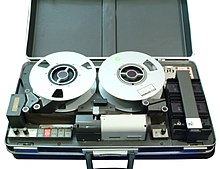Quadruplex录影带
此条目可参照英语维基百科相应条目来扩充。 |







多工多磁头录影带(英语:quadraplex,2-inch quad video tape,2-inch quadruplex videotape)是一种由Ampex公司开发的录影带格式,也是世界上第一种商业用电视录影带规格标准。[1][2][3]
历史
[编辑]最初制作电视节目一般采用两种方式:一种是用胶片摄影机把节目拍摄下来冲洗后再通过电子式扫描转换播出(比如经过胶片机放映,电视摄影机即时拍摄)采用这种方法的最大缺陷是无法实况转播电视节目。另外一种是用电视摄影机直接把节目转换电子讯号传播出去,虽然能满足那些希望实况转播的观众需要,缺点是不能储存、重复播放,美国东西岸时区时差缘故,美国电视业者迫切需求新技术和新机器来提升商业利益。
为此RCA、BCE和Ampex等多家公司开发各自的技术。Ampex制作多台实验性设备后,于1956年4月14日在芝加哥公开其名为mark IV(生产型号初为VRX-1000,最终改为VR-1000)展示机[4],电视摄影机现场拍摄,录制黑白视讯内容,随即拨放,效果震惊全场。随后Ampex公司推出采用开放式卷盘2英吋宽录影带(Ampex称为Quadruplex videotape) 和多工多磁头录影专利技术的VR-1000专业用录影机,被电视业者采用,促成电视业者节目内容更贴近观众需求[5]。Ampex后来采用日本马自达研究所(日语:マツダ研究所,Mazda Research Laboratory)泽崎宪一博士(Dr.Sawazaki Kenichi)在1953年发明螺旋扫描式磁鼓技术,用螺旋扫描式磁鼓写入读取磁带磁轨记录影像,以此新技术在1959年推出后续机种,成为电视广播行业录放影机规格标准,录影带从此可流通交换。[6][7][8]
专利名称
[编辑]“Quadruplex”名称是Ampex 注册商标,在磁鼓(英语:drum)上以90度间隔安装四个磁头,每个磁头各读取写入四分之一的视讯音频电信号在2英吋宽的磁带,磁带储存来自四个磁头汇聚电信号,磁带以每秒 7.5 或 15 英吋(190.5 或 381.0 毫米)的速度转动。音频、控制和提示音轨以标准线性方式记录在磁带边缘附近。第二个音轨被用作提示音轨;用于录音、线性视频编辑提示音、时间码。因磁头不同产生视讯音频失真且接缝明显的缺点,Ampex后来采用螺旋扫描式磁鼓技术取代自家的多工多磁头技术。
“Videotape”(录影带)名称是Ampex 注册商标,当时RCA 发展的录影机磁带品名自称为Television Tape Recorder(电视录音带)。[9]
技术规格
[编辑]- 2 Inch open reel to reel analog video system[10]
- Vacuum guide to support videotape for record
- Tape speed 15 ips. (381 mm/s) [7.5 ips in half speed mode)
- Video record FM signal
- One analog control track (240Hz) 20 mils [bottom of videotape]
- Two analog audio tracks: 2 audio tracks or one audio and one cue tone track or one audio track and one linear timecode track
- Analog audio track 70 mils [top of videotape]
- Analog audio cue track 20 mils
- Video track angle 89.5 deg.
- Video track height/length ~ 1.82 inches, ~ 46.2mm
- Four video record/play heads at 90 deg. (rotary transformer - Ampex, rotary brush - RCA)
- Drum dia. 2 inches - (5.08mm)
- Video penetration ~ .002 inches - 50 micron
- 525-lines video has 32 video tracks
- 625-lines video has 40 video tracks
- Video scanner rotation: 525 line 14,400 rpm (240 rps) (1,000 stripes per second), 625 15,000 rpm
- Video head write speed: 525 line 1508 ips (38.3 m/s), 625 39.9 m/sec (1570.8 ips)
- Video track width 10 mils - .25mm
- Video track pitch 15.6 mils - .40mm
- 16.4 horizontal lines per head in 525. (64 lines recorded per rotation of the head drum assembly)
- Video track per second 960.
- Studio reel ~60 minutes, 4,800 feet.
- Video FM modes: Low band, High Band, B&W, Super High Band
参考文献
[编辑]- ^ Digitise 2 inch Quadruplex video tape or Quad. greatbear audio and video digitising. 2019-09-07 [2021-07-18]. (原始内容存档于2021-07-20).
- ^ 2″ Quad Video Tape Transfers - new service offered. greatbear audio and video digitising. 2014-03-03 [2021-07-18]. (原始内容存档于2021-07-18).
- ^ Identify your audio tape or video tape - formats we digitise. greatbear audio and video digitising. [2021-07-18]. (原始内容存档于2021-07-20).
- ^ AMPEX VRX-1000 Video Tape Machine. HistoryOfRecording.com. [2021-07-18]. (原始内容存档于2021-07-18).
- ^ The Race to Video. [2011-01-22]. (原始内容存档于2011-04-04).
- ^ Toshiba Science Museum : World's First Helical Scan Video Tape Recorder. toshiba-mirai-kagakukan.jp. [2021-07-14]. (原始内容存档于2021-07-27).
- ^ 戦後日本のイノベーション100選 安定成長期 家庭用ビデオ(カセット). koueki.jiii.or.jp. [2021-07-18]. (原始内容存档于2021-07-18).
- ^ 川村俊明. History of the Video-Tape Recorder in Japan and the Preservation of (Early) Examples (PDF). [2021-07-14]. (原始内容 (PDF)存档于2021-07-26).
- ^ greatbear | audio and video tape transfer, digitising, preservation. greatbear audio and video digitising. [2021-07-18]. (原始内容存档于2021-07-18).
- ^ 2 inch Quad tape. [2021-07-14]. (原始内容存档于2021-07-14).
| |||||||||||||||||||||||||||||||||||||||||||||||
